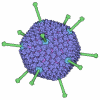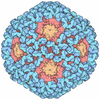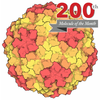[English] 日本語
 Yorodumi
Yorodumi- PDB-6hcr: Synthetic Self-assembling ADDomer Platform for Highly Efficient V... -
+ Open data
Open data
- Basic information
Basic information
| Entry | Database: PDB / ID: 6hcr | ||||||
|---|---|---|---|---|---|---|---|
| Title | Synthetic Self-assembling ADDomer Platform for Highly Efficient Vaccination by Genetically-encoded Multi-epitope Display | ||||||
 Components Components | Penton protein | ||||||
 Keywords Keywords |  VIRUS LIKE PARTICLE / VIRUS LIKE PARTICLE /  engineered / engineered /  virus / like / virus / like /  particle / ADDomer / Ad3 / particle / ADDomer / Ad3 /  penton / base / penton / base /  adenovirus / synthetic / adenovirus / synthetic /  vaccine / biobrick / vaccine / biobrick /  human / homosapien / human / homosapien /  dodecahedron / icosohedral / epitode / display / dodecahedron / icosohedral / epitode / display /  scaffold scaffold | ||||||
| Function / homology | Adenovirus penton base protein / Adenovirus penton base protein / T=25 icosahedral viral capsid / endocytosis involved in viral entry into host cell / host cell nucleus / structural molecule activity / virion attachment to host cell /  Penton protein Penton protein Function and homology information Function and homology information | ||||||
| Biological species |   Human adenovirus B serotype 3 Human adenovirus B serotype 3 | ||||||
| Method |  ELECTRON MICROSCOPY / ELECTRON MICROSCOPY /  single particle reconstruction / single particle reconstruction /  cryo EM / Resolution: 3.5 Å cryo EM / Resolution: 3.5 Å | ||||||
 Authors Authors | Bufton, J.C. / Berger, I. / Schaffitzel, C. / Garzoni, F. / Rabi, F.A. | ||||||
 Citation Citation |  Journal: Sci Adv / Year: 2019 Journal: Sci Adv / Year: 2019Title: Synthetic self-assembling ADDomer platform for highly efficient vaccination by genetically encoded multiepitope display. Authors: Charles Vragniau / Joshua C Bufton / Frédéric Garzoni / Emilie Stermann / Fruzsina Rabi / Céline Terrat / Mélanie Guidetti / Véronique Josserand / Matt Williams / Christopher J Woods / ...Authors: Charles Vragniau / Joshua C Bufton / Frédéric Garzoni / Emilie Stermann / Fruzsina Rabi / Céline Terrat / Mélanie Guidetti / Véronique Josserand / Matt Williams / Christopher J Woods / Gerardo Viedma / Phil Bates / Bernard Verrier / Laurence Chaperot / Christiane Schaffitzel / Imre Berger / Pascal Fender /   Abstract: Self-assembling virus-like particles represent highly attractive tools for developing next-generation vaccines and protein therapeutics. We created ADDomer, an adenovirus-derived multimeric protein- ...Self-assembling virus-like particles represent highly attractive tools for developing next-generation vaccines and protein therapeutics. We created ADDomer, an adenovirus-derived multimeric protein-based self-assembling nanoparticle scaffold engineered to facilitate plug-and-play display of multiple immunogenic epitopes from pathogens. We used cryo-electron microscopy at near-atomic resolution and implemented novel, cost-effective, high-performance cloud computing to reveal architectural features in unprecedented detail. We analyzed ADDomer interaction with components of the immune system and developed a promising first-in-kind ADDomer-based vaccine candidate to combat emerging Chikungunya infectious disease, exemplifying the potential of our approach. | ||||||
| History |
|
- Structure visualization
Structure visualization
| Movie |
 Movie viewer Movie viewer |
|---|---|
| Structure viewer | Molecule:  Molmil Molmil Jmol/JSmol Jmol/JSmol |
- Downloads & links
Downloads & links
- Download
Download
| PDBx/mmCIF format |  6hcr.cif.gz 6hcr.cif.gz | 4.4 MB | Display |  PDBx/mmCIF format PDBx/mmCIF format |
|---|---|---|---|---|
| PDB format |  pdb6hcr.ent.gz pdb6hcr.ent.gz | Display |  PDB format PDB format | |
| PDBx/mmJSON format |  6hcr.json.gz 6hcr.json.gz | Tree view |  PDBx/mmJSON format PDBx/mmJSON format | |
| Others |  Other downloads Other downloads |
-Validation report
| Arichive directory |  https://data.pdbj.org/pub/pdb/validation_reports/hc/6hcr https://data.pdbj.org/pub/pdb/validation_reports/hc/6hcr ftp://data.pdbj.org/pub/pdb/validation_reports/hc/6hcr ftp://data.pdbj.org/pub/pdb/validation_reports/hc/6hcr | HTTPS FTP |
|---|
-Related structure data
| Related structure data |  0198MC M: map data used to model this data C: citing same article ( |
|---|---|
| Similar structure data |
- Links
Links
- Assembly
Assembly
| Deposited unit | 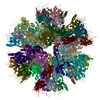
|
|---|---|
| 1 |
|
- Components
Components
| #1: Protein |  / CP-P / Penton base protein / Protein III / CP-P / Penton base protein / Protein IIIMass: 63598.293 Da / Num. of mol.: 60 Source method: isolated from a genetically manipulated source Source: (gene. exp.)   Human adenovirus B serotype 3 / Gene: L2 Human adenovirus B serotype 3 / Gene: L2Cell line (production host): High Five Cells (BTI-TN-5B1-4) Production host:   Trichoplusia ni (cabbage looper) / References: UniProt: Q2Y0H9 Trichoplusia ni (cabbage looper) / References: UniProt: Q2Y0H9 |
|---|
-Experimental details
-Experiment
| Experiment | Method:  ELECTRON MICROSCOPY ELECTRON MICROSCOPY |
|---|---|
| EM experiment | Aggregation state: PARTICLE / 3D reconstruction method:  single particle reconstruction single particle reconstruction |
- Sample preparation
Sample preparation
| Component | Name: ADDomer: An engineered viral like particle derived from penton base protein of Human adenovirus B3 (Ad3). Type: COMPLEX Details: Recombinantly expressed and purified ADDomer complex (penton base dodecahedron). Entity ID: all / Source: RECOMBINANT |
|---|---|
| Molecular weight | Value: 3.811834 MDa / Experimental value: NO |
| Source (natural) | Organism:   Human adenovirus B3 Human adenovirus B3 |
| Source (recombinant) | Organism:   Trichoplusia ni (cabbage looper) Trichoplusia ni (cabbage looper) |
| Buffer solution | pH: 7.5 |
| Specimen | Embedding applied: NO / Shadowing applied: NO / Staining applied : NO / Vitrification applied : NO / Vitrification applied : YES : YES |
| Specimen support | Grid material: COPPER / Grid type: Quantifoil R2/2 |
Vitrification | Instrument: LEICA EM GP / Cryogen name: ETHANE |
- Electron microscopy imaging
Electron microscopy imaging
| Experimental equipment | 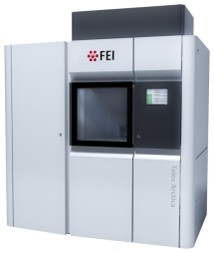 Model: Talos Arctica / Image courtesy: FEI Company |
|---|---|
| Microscopy | Model: FEI TALOS ARCTICA |
| Electron gun | Electron source : :  FIELD EMISSION GUN / Accelerating voltage: 200 kV / Illumination mode: FLOOD BEAM FIELD EMISSION GUN / Accelerating voltage: 200 kV / Illumination mode: FLOOD BEAM |
| Electron lens | Mode: BRIGHT FIELD Bright-field microscopy / Nominal magnification: 130000 X / Nominal defocus max: 3200 nm / Nominal defocus min: 800 nm / Cs Bright-field microscopy / Nominal magnification: 130000 X / Nominal defocus max: 3200 nm / Nominal defocus min: 800 nm / Cs : 2.7 mm : 2.7 mm |
| Image recording | Average exposure time: 0.25 sec. / Electron dose: 1.3125 e/Å2 / Detector mode: COUNTING / Film or detector model: GATAN K2 SUMMIT (4k x 4k) / Num. of real images: 1060 |
| Image scans | Movie frames/image: 32 |
- Processing
Processing
| EM software |
| ||||||||||||||||||||||||||||||||||||||||||||||||||
|---|---|---|---|---|---|---|---|---|---|---|---|---|---|---|---|---|---|---|---|---|---|---|---|---|---|---|---|---|---|---|---|---|---|---|---|---|---|---|---|---|---|---|---|---|---|---|---|---|---|---|---|
CTF correction | Type: PHASE FLIPPING AND AMPLITUDE CORRECTION | ||||||||||||||||||||||||||||||||||||||||||||||||||
| Symmetry | Point symmetry : I (icosahedral : I (icosahedral ) ) | ||||||||||||||||||||||||||||||||||||||||||||||||||
3D reconstruction | Resolution: 3.5 Å / Resolution method: FSC 0.143 CUT-OFF / Num. of particles: 1758 / Symmetry type: POINT | ||||||||||||||||||||||||||||||||||||||||||||||||||
| Atomic model building | Protocol: BACKBONE TRACE / Space: REAL Details: The model was adjusted to fit into the map manually using COOT before further iterative positional and B-factor refinement in real space using Phenix Real-Space refinement software. Final ...Details: The model was adjusted to fit into the map manually using COOT before further iterative positional and B-factor refinement in real space using Phenix Real-Space refinement software. Final adjustments were carried out in COOT. | ||||||||||||||||||||||||||||||||||||||||||||||||||
| Atomic model building | PDB-ID: 4AR2 Pdb chain-ID: A / Pdb chain residue range: 61-542 |
 Movie
Movie Controller
Controller



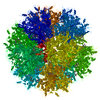
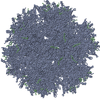


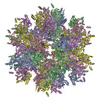
 PDBj
PDBj